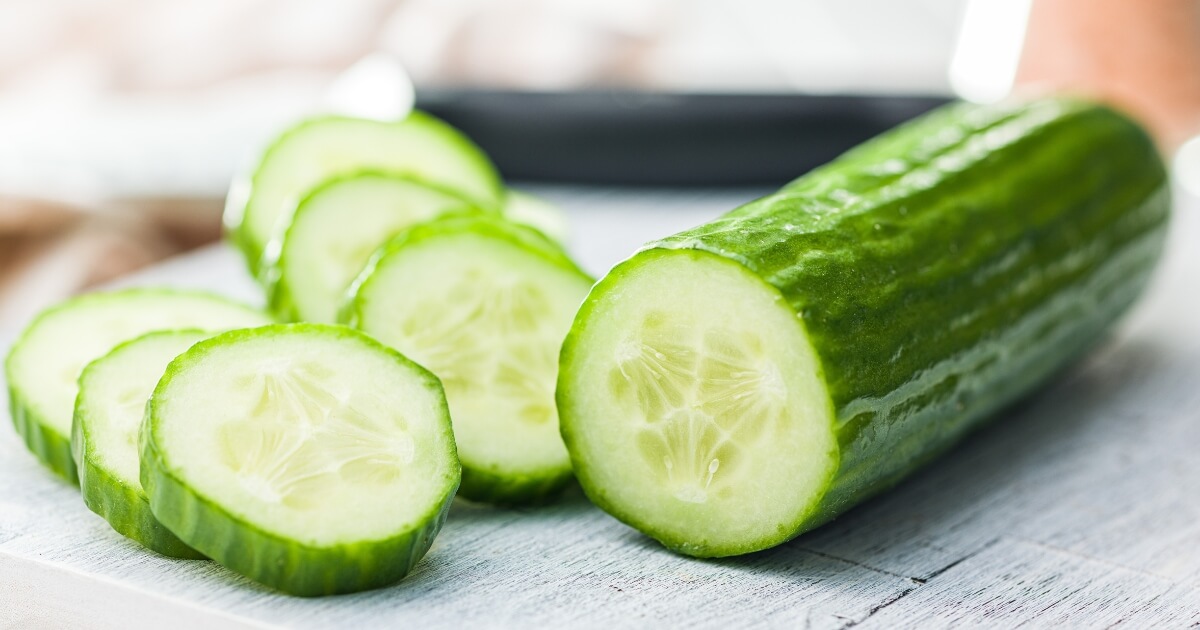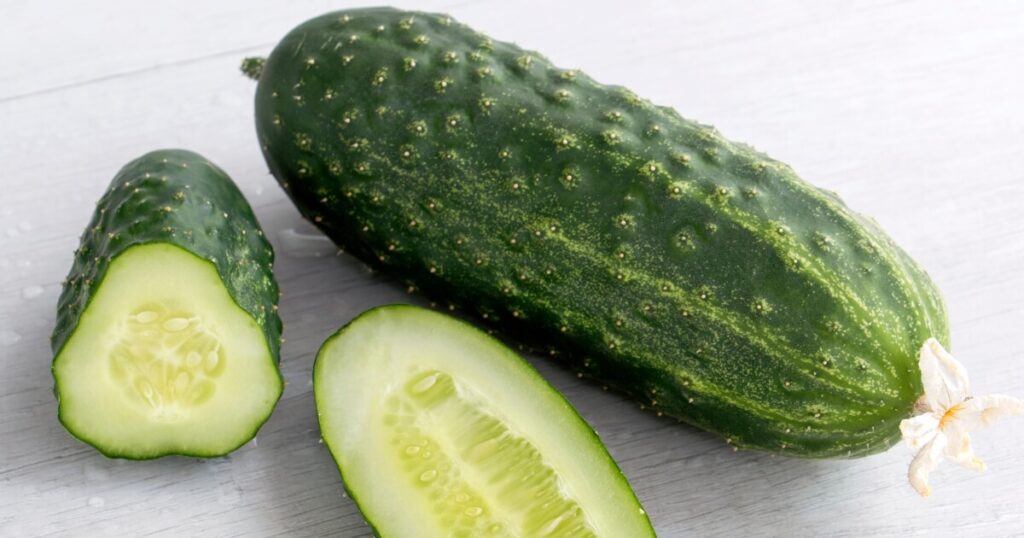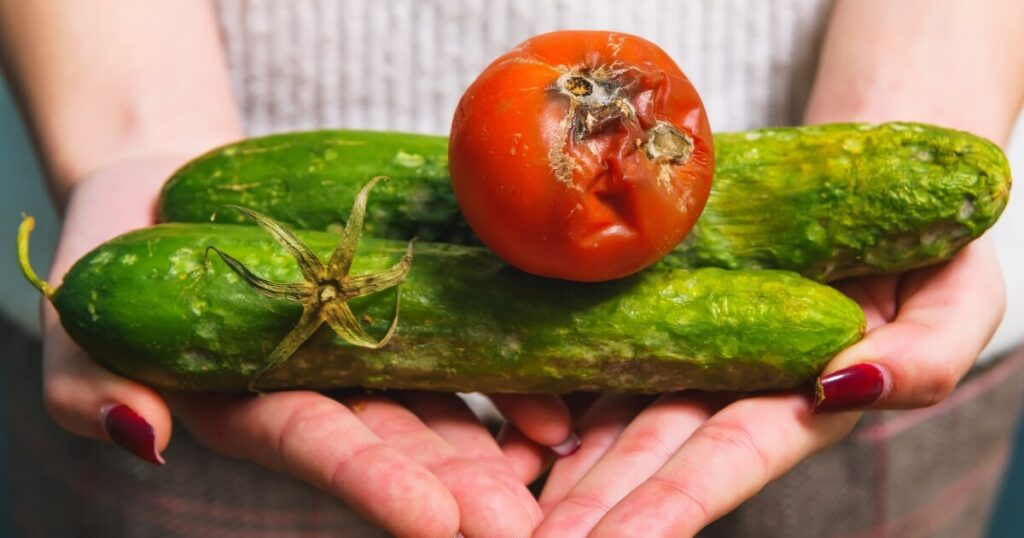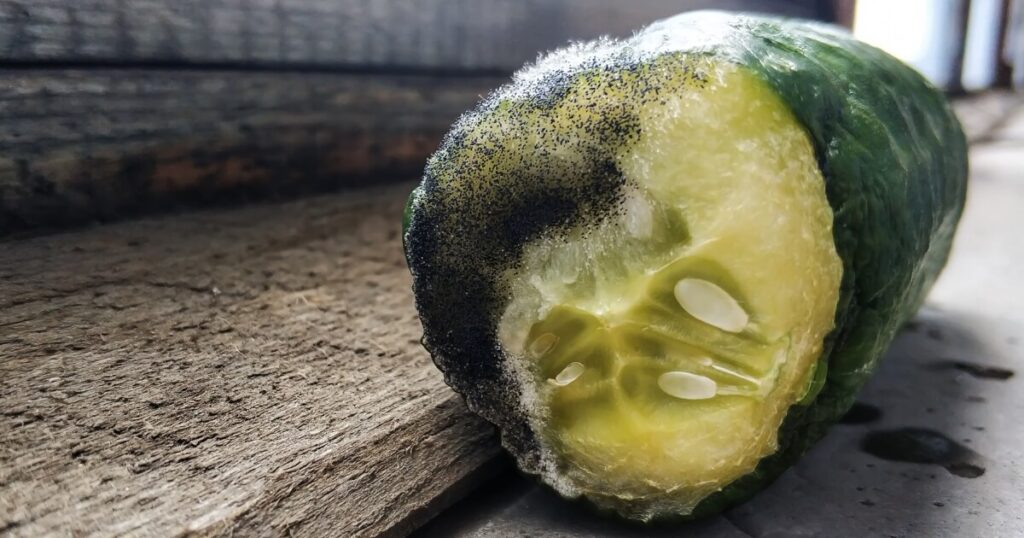I love using English cucumbers for a refreshing crunch to salads and sandwiches. But how can you tell when a cucumber has gone bad?
Like any fresh veggie, cucumbers have telltale signs of going south. The most obvious sign? Softness and a color change.

A fresh cucumber should be firm, vibrant green, and have a subtle, earthy aroma. If you notice any sliminess, dark spots, or an off-putting smell, it’s time to toss it.
Nobody wants to use a spoiled cucumber which could ruin their meal and make them sick, right? In this guide, I’ll walk you through signs of spoilage to look for that indicate your cucumber has seen better days.
How To Know If Cucumber Is Bad
To get straight to the point, here is a quick comparison of the differences between a fresh and spoiled cucumber.
What Does A Good Cucumber Look Like:

- Dark green color skin.
- A crisp texture that yields to gentle pressure when squeezed.
- Fresh, slightly earthy aroma.
- Crisp, watery flesh that’s refreshing when tasted.
What Does A Bad Cucumber Look Like:

- The skin has sunken areas or dents.
- Very soft patches or mushy texture when squeezed.
- Presence of mold or an off-putting smell.
- Tastes sour or has an off flavor.
If you’re wondering about the best ways to store cucumbers to maximize their freshness, do check out my other article, “How long cucumbers last.” It’s got all the shelf life tips you need to keep them crisp and fresh for longer.
Softness and Mushiness
Cucumbers have high water content, but a soft or mushy cucumber often indicates that it is overripe or bacterial growth. This change in texture can clearly indicate that the cucumber is past its prime and may not be safe to eat.

I’ve noticed that cucumbers tend to get soft quickly, especially at the ends, when they’ve been sitting around for too long. It’s usually accompanied by a change in color, moving from a vibrant green to a duller shade.
Bacterial growth can also be a culprit behind that mushy feel. This can be the result of the decomposition process or if they’ve been stored with too much moisture.
Storing washed cucumbers in a plastic bag or plastic wrap and then tossing them in the fridge will result in soft and slimy cucumbers in just a few days.
To prevent a shorter shelf life, it’s best to store cucumbers in a dry, cool place to prevent bacterial growth and maintain their crispness.
Slimy Surface and Milky Sheen
A cucumber with a slimy texture or a white, milky sheen is usually a victim of excess moisture, which has encouraged bacterial growth. This isn’t just an aesthetic issue!
It’s a sign that the cucumber is no longer safe to eat.
I’ve come across this a few times, especially during the humid summer months. Once, after a grocery trip, I left the fresh cucumbers in a plastic bag from the grocery store and forgot about them. By the time I remembered, they had developed that unmistakable slimy feel and milky appearance.
Bacterial activity on cucumbers isn’t something to take lightly. You can’t just wash off the slime and use the cucumber. It’s always better to be safe and discard those cucumbers.
Black Spots Or Yellow Patches
When you notice dark, black spots on a cucumber, it’s often due to aging, a fungal infection, or bruising. These blemishes can be early signs that the cucumber is starting to mold or decay.

Bruising can sometimes lead to these darkened areas, and while a small spot might be okay to cut out, widespread discoloration is a red flag.
Yellow patches could be from a lack of nutrition while the cucumber was growing or bad ripening conditions. It’s best to skip these cucumbers, especially if they turn yellow while in your fridge.
Always check your fresh produce carefully and use them promptly to avoid such problems.
Fungal infections can be a cause of spots, but it’s more common on the leaves of the plant rather than the cucumber itself. Skip the cucumbers if they aren’t looking good at your grocery store.
Foul Odor Or Sour Taste
If a cucumber has a bad smell or an off-putting taste, it’s typically due to bacterial or mold growth.
They indicate that the cucumber is spoiled! Rotten cucumbers should not be consumed.
I’ve always believed that our senses are one of the best tools in the kitchen. If you took a bite from a cucumber that looked fine on the outside but tasted sour, it’s best to trust your taste buds and avoid eating it.
Mold Growth
Mold growth on a cucumber is usually the result of damp storage conditions.

This isn’t just a surface issue. Mold can penetrate deeper into the cucumber and may produce harmful toxins.
In my cooking adventures, I’ve encountered mold on cucumbers a couple of times. It’s always the one that was able to get lost at the back of my crisper drawer for just long enough to develop fuzzy patches of mold.
While it might be tempting to just cut off the moldy part and use the rest, it’s not a risk worth taking.
I read about the Mycotoxins mold can produce, so I always play it safe and discard the entire cucumber if there’s any sign of mold.
What Happens If You Eat A Bad Cucumber?
If you accidentally consume a spoiled cucumber, your body might not be too happy about it.
Eating bad cucumbers can lead to food poisoning with symptoms like stomach cramps, diarrhea, and nausea.
If you suspect you’ve eaten a bad cucumber, staying hydrated is essential. After eating something questionable, my go-to remedy is to sip on some ginger tea. It’s soothing and can help settle an upset stomach.
However, if symptoms persist or are severe, seeking medical attention is crucial. While many cases are mild and resolve on their own, it’s always better to be cautious.
I’ve always believed in listening to your body. If it’s telling you something’s not right, it’s best to get it checked out by your doctor.
Bad Cucumber FAQs
How do you tell if a cucumber is bad inside?
When you slice open a cucumber, a fresh one should have crisp, moist flesh. If it’s discolored, has a sour smell, or feels mushy, it’s likely bad inside.
Can you wash off slimy cucumbers?
While you might be tempted to rinse off the slime, it’s a sign of bacterial growth. It’s best to discard slimy cucumbers to ensure you’re not consuming harmful bacteria.
Is it okay to eat soft cucumbers?
A soft cucumber, especially at the ends, has started to dehydrate as part of the decaying process. Overripe cucumbers should be avoided, while a slightly soft spot might be cut out.
How long does it take for a cucumber to go bad?
A cucumber can last up to a week when stored properly in the fridge. However, it can spoil faster if exposed to moisture or warm temperatures.











